Mi SciELO
Servicios Personalizados
Revista
Articulo
Indicadores
-
 Citado por SciELO
Citado por SciELO -
 Accesos
Accesos
Links relacionados
-
 Citado por Google
Citado por Google -
 Similares en
SciELO
Similares en
SciELO -
 Similares en Google
Similares en Google
Compartir
Archivos Españoles de Urología (Ed. impresa)
versión impresa ISSN 0004-0614
Arch. Esp. Urol. vol.62 no.5 jun. 2009
Prospective randomized study on the use of lidocaine local anesthesia in prostate biopsy
Estudio prospectivo randomizado sobre el uso de anestesia local con lidocaína en la biopsia prostática
Ana Montoliu García, Joaquín Juan Escudero, Macarena Ramos de Campos, Milagros Fabuel Deltoro, Francisco Serrano de la Cruz Torrijos, Ariana Álvarez Barrera and Emilio Marques Vidal.
Department of Urology. Consorcio Hospital General Universitario de Valencia. Valencia. Spain.
SUMMARY
Objectives: Transrectal ultrasonography-guided prostate biopsy is still the main technique in prostate cancer diagnosis. In spite of being a relatively well-tolerated exploration, often results in an awkward and painful procedure, especially in those cases in which the number of samples increase.
We designed a prospective randomized study that compares biopsies tolerance with the use of intravenous analgesia and intrarectal gel with or without intracapsular prostatic anesthesia.
Methods: We have included an amount of 80 procedures between June 2006 and December 2007. Intravenous analgesia was given to all patients and 12.5 gr. of lidocaine gel (which contains 250 mg of lidocaine hydrochloride) was instilled into the rectal vault. All patients underwent methodically 10 cores biopsy after having an intracapsular injection of 8 ml. of 2% lidocaine in a randomized group. A questionnaire with three measurements of the visual analogue scale of pain was given immediately after the procedure and another one thirty minutes later, as well as a satisfaction survey.
Results: The average age of patients in control group was 68 years (48-73 range) and 69 years (50-75 range) in treatment group. The average PSA was 7.1 ng/ mL (4.8-9.8 range) in the first group and 7.3 ng/mL (4.5-9.7 range) in the second one. Average pain in the visual analogue scale in patients without intracapsular anesthesia was 8.3 (2 - 9) in the first questionnaire and 2 (0 - 4) in the second one, against 4 (0 - 8) and 1.33 (0 - 2) of the group who did receive anesthesia. If we compare both groups, we find statistically significant differences only in immediately measurements (p<0,01), not in the second questionnaire (p=0,2). We didn't find statistically significant differences as for urethral bleeding, rectorrhagia or infection between both groups.
Conclusion: We consider the injection of intracapsular lidocaine a reproductible technique and effective for both improving tolerance and diminishing the pain related to transrectal ultrasound-guided prostate biopsy without increasing morbidity.
Key words: Prostatic biopsy. Local anesthesia. Prostate cancer.
RESUMEN
Objetivos: La biopsia prostática transrectal ecodirigida continúa siendo la técnica fundamental en el diagnóstico del cáncer de próstata. A pesar de ser una exploración relativamente bien tolerada, en muchas ocasiones resulta un procedimiento incómodo y doloroso, sobre todo en aquellos casos en los que se amplía el número de cilindros tomados.
Presentamos un estudio prospectivo randomizado que compara la tolerancia a la biopsia con el uso de analgesia endovenosa y gel intra-rectal con y sin anestesia prostática intracapsular.
Métodos: Entre junio 2006 y diciembre 2007 hemos incluido un total de 80 procedimientos. En todos los pacientes se administró un analgésico endovenoso y se aplicaron 12,5 gr de gel con 250 mgr de hidrocloruro de lidocaína intra-rectal. En todos se realizó sistemáticamente la toma de 10 cilindros, previa inyección intracapsular de 8 mL de lidocaína al 2% en el grupo aleatorizado. Para ello se entregó un cuestionario con tres medidas de escala analógica visual del dolor inmediatamente tras el procedimento, y otro treinta minutos después, así como una encuesta de satisfacción.
Resultados: La edad media de nuestros pacientes fue de 68 años (rango 48 - 73) en el grupo que no recibió anestesia y de 69 años (rango 50 - 75) en el que sí la recibió. El PSA medio fue 7'1 ng/mL (rango 4'8 - 9'8) en el primer grupo y 7'3 ng/mL (rango 4'5 - 9'7) en el segundo. La media de dolor en la escala analógica visual en los pacientes sin anestesia intracapsular fue de 8,3 (2 - 9) en la primera encuesta y 2 (0 - 4) en la segunda, frente a 4 (0 - 8) y 1,33 (0 - 2) del grupo que sí la recibió. Al comparar ambos grupos encontramos diferencias estadísticamente significativas sólo en la valoración inmediata a la biopsia (p<0,01), no así en el segundo cuestionario (p=0,2). No encontramos diferencias estadísticamente significativas en cuanto a uretrorragia, rectorragia o infección entre ambos grupos.
Conclusión: Consideramos la inyección de lidocaína intracapsular una técnica reproducible y efectiva en cuanto a mejorar la tolerancia y disminuir el dolor asociado a la realización de biopsia prostática transrectal ecodirigida, sin incrementar la morbilidad del procedimiento.
Palabras clave: Biopsia prostática. Anestesia local. Cáncer de próstata.
Introduction
Global incidence of prostate cancer exceeds the 500.000 cases/year and is nowadays the most frequent cancer in male (1). This makes its diagnosis a subject of constant revision and study. The introduction 25 years ago of prostatic specific antigen (PSA) as a tumoral marker, has increased the indications of prostatic biopsies, and the present tendency to diminish the cut-off point into values under 4 ng/mL makes the number of biopsies performed grow even more (2,3).
In parallel to this increase of indications, most of the authors agree in considering inadequate the classical scheme of Hodge's sextant biopsy, because nowadays it does exist lots of biopsy schemes increased to 10, 12 or even 18 cylinders that have shown an increase on cancer detection rate (4).
Prostatic biopsy is performed generally in outpatient program. Patients who have to undergo this test show anxiety because of the possibility of being diagnosed with cancer and because of the necessity of suffering a transrectal ultrasound scan (5). The insertion of the probe into the rectal vault is awkward and prostatic puncture is painful (6). The obtaining of more number of cores at the expense of directing the puncture to more lateral areas makes this technique one of the worst tolerated.
All these things make the performance of prostatic biopsy an awkward technique and sometimes not well tolerated. Because of this, in recent years the interest in performing biopsy with the higher comfort for the patient has grown up, even considering the necessity for applying some anesthetic technique which allows obtaining prostatic tissue according to extended schemes improving tolerance and without making more complexity of the procedure.
Many techniques have been described to improve this tolerance, from intravenous analgesia to sedation, with very variable results, but the majority of studies agree in pointing out techniques that use local anesthetics as the most effective on the decrease of associated pain to the prostatic biopsy. Nowadays, there are lots of centers using any type of anesthetic technique associated to biopsy routinely.
With the aim to prove the utility of anesthesia for improving the tolerance to prostatic biopsy, we present a study to compare the effectiveness of intravenous analgesia and intrarectal gel with and without intracapsular prostatic anesthesia.
Materials and methods
We designed a simple blind prospective randomized study. Inclusion criteria were: the first prostatic biopsy for the patient, younger than 75 years and that the PSA determination was between 4 and 10 ng/mL. We excluded those patients with suspicious digital rectal exam and those who suffered from pelvic pain of any etiology, and also patients with anal sphincter hypertonia and those allergic to lidocaine (Table I).
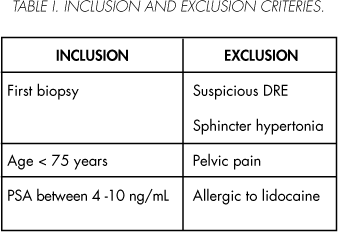
Patients included in the study were randomized acording the number of medical history in two groups, even versus odd, the first one for receiving intracapsular anesthesia and the second one for performing a biopsy without anesthesia.
Both groups underwent the same preparation consisting of antibiotic prophylaxis with ciprofloxacin 500 mg. orally twice a day for 4 days beginning the previous day and a cleaning enema of 250 ml. 2 hours before the performance of the biopsy. All patients received as well intravenous analgesia with 2 gr. of magnesic metamizol 30 minutes before the test, and 12.5 gr of lubricating intrarectal gel that contains 250 mg of lidocaine hydrochloride (Cathejell®) used a few minutes before the practice.
The performing technique of biopsy was the same for all patients. We used an ultrasound scanner Aloka® SSD-1400 with intrarectal transducer of 5 MHz. 10 cores were taken according to a systematic scheme (Figure 1) using a one-stroke spring device with puncture needle of 18 G and 20 cm long which extracts tissular cylinders of 1,5 cm. long and 0.1 cm. thick.
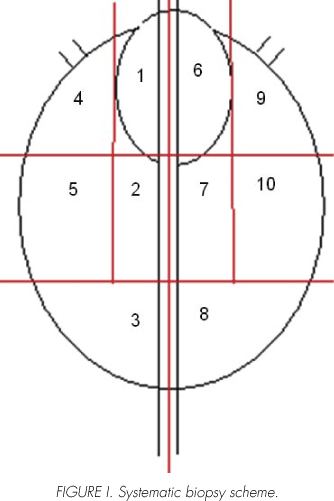
In treatment group, it was performed previously intracapsular anesthesia with 2% lidocaine using a 22 G Chiba needle (0'7 x 203 mm) with echographic transrectal guide, by injecting intracapsularly 4 mL on each side at the entry level of the prostatic vascular pedicle.
We collected age, PSA, prostatic volume, PSA density and suspicious areas in ultrasound scans data from all patients.
When the technique was finished, all patients were given and explained a questionnaire consisting of three visual analogue pain scales to be answered immediately. This scales valued the pain from 0 (the total absence of pain) to 10 (the greatest pain suffered ever by the patient) (Figure 2). Thirty minutes later, in the recovery room, an identical questionnaire was given and also a satisfaction survey which valuates questions as the environment perception during the procedure, comfort during the technique, the knowledge about the process, the personnel's attention and the disposition for undergoing the technique again. This survey classifies the degree of satisfaction of the patients in 4 groups: bad, regular, good and very good.
All patients had a later revision in an outpatient consultation where were depicted the complications derived from biopsy.
The statistical analysis of data picked up was made with SPSS 12.0 Spanish version.
Results
We included a total of 80 prostatic biopsies carried out in our hospital between June 2006 and December 2007. 38 of these 80 patients received intravenous analgesia and intrarectal gel and 42 received intracapsular anesthesia too. All of them filled in the 2 questionnaires about pain and the satisfaction survey. All of them came to the next visit.
The average age of our patients was of 68 years (range between 48 and 73) in control group and 69 years (range between 50 and 73) in treatment group. The average PSA was 7.1 ng/mL (range 4.8 - 9.8) in the first group and 7.3 ng/mL (range 4.5 - 9.7) in the second one. Differences in these parameters between two groups were not statistically significant.
Complications that required treatment in the emergency department in the following 48 hours to the biopsy were registered in 5 patients: 2 of the group that only received analgesia (1 hematuria, 1 acute urine retention), and 3 from the group that received, furthermore, local anesthesia (1 febrile syndrome, 1 hematuria, 1 rectorrhagia). Only the patient that suffered rectorrhagia had to be hospitalized, and the manifestations were solved in 24 hours with expectant attitude without requiring hemotransfusion. It wasn't observed statistical significance as to the difference in the distribution of complications between both groups.
The group that received intracapsular anesthesia with lidocaine valued the pain sensed in the immediate moment to the biopsy with an average of 4 (range 0 - 8), compared to the 8.3 average in the group that didn't receive anesthesia (range 2 - 9). After comparing the averages by T-Student's test, we appreciate that in the first survey differences are statistically significant (p < 0.01). The average obtained in the survey 30 minutes later was lower into the two groups: 1.33 (range 0 - 2) in the group that received anesthesia and 2 (range 0 - 4) in the group that didn't receive. The difference between these measurements didn't result, on the other hand, statistically significant (p = 0.2) (Table II).
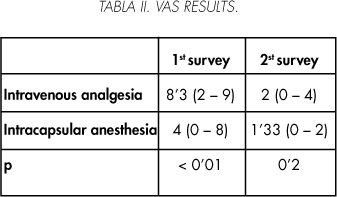
As for the results of the satisfaction survey, the tolerance in the group that only received intravenous analgesia was bad in 5 patients, regular in 19 and good in 13, being very good in one of them. In patients with intracapsular anesthesia only one won't tolerated the biopsy, 6 valuated the technique as regular and 2 as very good, finding the major number of results in the group of good tolerance with 33 patients. (Table III - Figure III).
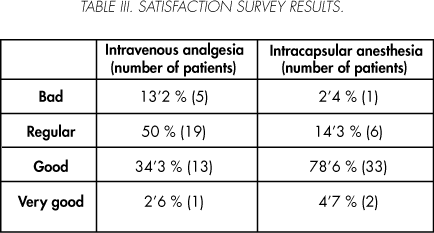
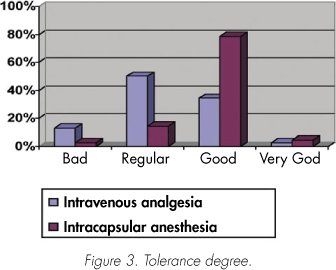
Discussion
Prostatic biopsy is the main technique in prostate cancer diagnosis. The increase in indications of biopsy produced in the last years and the increase in the number of samples obtained in each biopsy has made to think in the necessity of performing, simultaneously to the biopsy, any other method for controlling the pain, with the aim of making this test a well tolerated one (7).
The choice of the type of anesthetic or analgesic method is a debated subject. Intravenous administration of AINES and analgesics were the traditional drugs employed, however they have been inferior controlling the pain in comparison with the new methods that use local anesthetics (8).
Until nowadays, in our center we performed the prostatic biopsy only with the previous administration of an intravenous analgesic (magnesic metamizol). If we increase the number of prostatic punctures per biopsy, changing the sextant traditional schedule to the extended biopsy up to 10 cylinders, we show an increase in patients inconvenience and a decrease of tolerance to this procedure. This made us to consider the necessity of using any anesthetic technique, and also the execution of this study for comparing the new method with the one we used previously.
We randomized patients depending on the number of the medical history and we adopted inclusion and exclusion criteria to try to give uniformity to the group of patients in order to make the perception of the pain not altered by factors different from the biopsy itself. We included patients with PSA levels between 4 and 10 ng/mL because in that range of values we only took 10 cylinders according to our systematic scheme and we didn't indicate biopsy of seminal vesicles. We only included the first biopsies because in later biopsies we increase the number of cylinders. With these two inclusion criteria we avoid the possible increase of pain by carrying out a greater number of punctures and with the second one we avoided, besides, the change in the perception of pain conditioned by memories of previous biopsies. We excluded patients with suspicious digital rectal exam for the same reason, given that in the case of nodules in the digital rectal exam we carried out an additional puncture on this zone. Patients with anal sphincter hypertonia or pelvic pain from other etiology were excluded in order to make pain surveys only valuate the pain attributed to the performance of prostatic biopsy.
Regarding to the way of diminishing the pain, there are several techniques used, being traditionally common used the application of intrarectal lidocaine gel. The studies' results with this method are very controversial. It has been studied too the use of different intravenous analgesics with very variable results (9,10). The periprostatic blockage with injection of local anesthetic is the most novel technique with large numbers of studies that justify its use, being nowadays the most widespread method (11). However, it still doesn't exist unanimity in which is the best place for injecting the anesthetic (12), some authors apply for the injection in prostatic-seminal angle of bilateral form and other who use the injection in periprostatic fat in apex, and also the ones who perform the injection intracapsularly.
Techniques described with local anesthetics are varied; there are many studies which compare the new methods ones between the others. Mallick and his collaborators for example, defend the use of external anesthetics of intrarectal application by using 15 mL of gel with 2% lidocaine. These authors carried out a study comparing gel with periprostatic injection of 10 mL of 1% lidocaine obtaining better results that the ones using just gel (13,14). Klaus and collaborators use external lidocaine too, but in suppository form that contains 60 mg, obtaining better results with this technique than with the use of intrarectal gel with 200 mg of lidocaine (15). We find also authors that don't find significant differences comparising gel with lidocaine and lubricating gel without anesthetic (16).
Although some studies seem to show that the use of lubricating gel with lidocaine of intrarectal application could diminish the pain associated to the moment of introducing the echographic transducer in the anal canal, this result proves to be misleading in the major part of studies because the pain valuation is carried out in the surveys jointly to the totality of the test (17). The purpose of our study wasn't to diminish pain associated to the introduction of transducer in the anal canal because our pain valuation is based on the moment of the prostatic puncture. Because of all these things, our patients receive as intrarectal lubricant the gel with lidocaine, since we don't try to value the validity of this gel as an anesthetic method. With our study is observed as well that the taking of samples produces pain to the patient, since if we reduce feelings with local anesthesia, we obtain significant differences in the pain perceived during the performance of the test.
The periprostatic nervous blockage described by Nash in 1996 (18) consists on the injection of local anesthetic in periprostatic tissue by using an echographic transrectal guide. Although the first study made by this author didn't show conclusive results in favor of this technique, later prospective randomized studies have shown the superiority of periprostatic blockage in the pain control compared to external anesthetics and compared to intravenous analgesics (19,20). As regards of nervous blockage technique, it still exists nowadays a huge controversy about the type of anesthetic to use, the dose and the place for making the puncture. Some authors have carried out randomized studies that compare the use of lidocaine with the combination of lidocaine/bupivacaine finding statistically significant differences in favor of the combination in some cases (21) but without proving them in other ones (22). The majority of authors opted finally for the use of lidocaine and the greatest part of studies that we find in literature refers to it presenting each one different preferences regarding to the place for inoculation and the volume of drug used (23). Nash and his collaborators suggested the injection of lidocaine in prostato-seminal angle bilaterally. Seymur and cols. performed the technique by puncture in the prostatic apex, between the capsule and the Denonvilliers' fascia (24). This technique has proved its effectiveness in other studies, justifying the complete prostatic anesthesia by the migration of lidocaine through the space of the fascia and reaching the lateral borders of the prostate and the prostato-seminal angles (25). Lee and collaborators perform the puncture of intraprostatic lidocaine of bilateral form at the level of the entry to the vasculo-nervous pedicle, with periprostatic lidocaine injection too (26). Mutaguchi and collaborators use the periprostatic lidocaine injection as well (27). Philip and collaborators carried out a randomized study comparing two locations of lidocaine puncture (base versus apex) finding that don't exist significant differences in the valuation of pain (28).
We chose the use of lidocaine versus the other local anesthetics like mepivacaine and bupivacaine because of its fastest action despite its less lasting effect. In a center like ours, the optimization of resources and time is the key factor in practice and is not desirable to delay the sample taking by waiting for the anesthetic effect and by prolonging the total time. On the other hand, as this study shows, it has not the same clinical importance the pain during the procedure and the pain registered 30 minutes later, which is similar in both groups, and that's the reason why we think that the longer duration of anesthetic effect isn't as important as the faster action in these patients. We chose the intracapsular application for the technical simplicity of this method, the rapidity of its learning and its effectiveness.
Our study has shown statistically significant differences regarding to the control of the pain between the prostatic nervous blockage technique and intravenous analgesics with external anesthetic, at least in the immediate moment after the biopsy. We have shown differences regarding to the perception of pain in the 30 postoperative minutes, although this difference has not been statistically significant. This could be due to the small sample in our study. Other reason that may explain this lack of significant differences in the second survey is the progressive disappearance of pain which all patients feel, since pain produced by the biopsy is secondary to the puncture, in an acute way, making that the valuation, done by patients who have received anesthesia and those who haven't, become more similar as time goes by because both groups show a decrease of pain after finishing the biopsy and it's very similar the perception (or memory) of pain 30 minutes after the puncture. A study with a major number of patients might be considered in order to value if this difference isn't really significant and responds to a physiological cause.
With the use of this technique we haven't observed an increase of morbidity in biopsy and our complication's rate remains similar to the previous one. This is also described in the study of Rodriguez and cols performed in 110 patients (29) and in the Addla and cols in 98 patients (30), amongst others31. In our case, the patient who presented rectorrhagia was one member of the group that received intracapsular anesthesia. Despite of not being a patient taking an antiaggregant and anticoagulant treatment, this complication needed the admission in a hospital for evolutive control. We didn't make any therapeutic attitude, except the order of complete rest. Patient didn't require hemotransfusion and was discharged 24 hours later completely asymptomatic. Although in this study only has been objectified rectorrhagia of clinic entity in one patient, this complication is frequent and we don't consider that our case can be secondary to the injection of local anesthetic. This technique, then, doesn't increase in our serie the morbidity associated to prostatic biopsy.
Since prostatic puncture is painful, obtaining an effective anesthetic method like intracapsular injection of lidocaine allows us to increase the number of samples in each biopsy without increasing the inconvenience and the pain perceived by the patient, and that contributes positively to the use of biopsy schemes increased to 12, 18 or even more cores. This represents an improvement on the profitability of prostatic biopsy that allows diminishing the indications of repetition biopsies.
Conclusion
Intracapsular injection of lidocaine is a reproductible technique, well tolerated by patients, that don't increase the procedure's morbidity and effective as for improving tolerance and diminishing the pain related to transrectal ultrasonography-guided prostate biopsy. This allows us to raise up the number of samples, increasing the profitability of diagnosis, whithout increase patient's discomfort.
 Correspondence:
Correspondence:
Ana Montoliu García
Pz. Dos de Mayo, 3, 4o-B
12540 Vila-real. Castellón. (Spain).
ana_montoliu@hotmail.com
Accepted: September 8th, 2008.
References and recomended readings (*of special interest, **of outstanding interest)
1. Bray F, Sankila R, Ferlay J, Parkin DM. Estimates of cancer incidence and mortality in Europe in 1995. Eur J Cancer, 2002; 38: 99. [ Links ]
2. Catalona W J, Loeb S. The PSA era is not over for prostate cancer. Eur Urol, 2005; 48: 541. [ Links ]
3. Schroder F H, Van der Cruijsen-Koeter I, de Koning H J, Vis A N, Hoedemaeker R F, Kranse R. Prostate cancer detection at low prostate specific antigen. J Urol, 2000; 163: 806. [ Links ]
4. Presti J C. Prostate biopsy: current status and limitations. Rev Urol, 2007; 9: 93. [ Links ]
**5. Collins G N, Lloyd S N, Hehir M, et al. Multiple transrectal ultrasound-guided prostatic biopsies-true morbidity and patient acceptance. Br J Urol, 1993; 71: 460. [ Links ]
6. Irani J, Fournier F, Bon D, et al. Patient tolerance of transrectal ultrasound-guided biopsy of the prostate. Br J Urol, 1997; 79: 608. [ Links ]
*7. De Sio M, D'Armiento M, Di Lorenzo G, et al. The need to reduce patient discomfort during transrectal ultrasonography-guided prostate biopsy: what do we know? BJU Int, 2005; 96: 977. [ Links ]
**8. Song S H, Kim J K, Song K, et al. Effectiveness of local anaesthesia techniques in patients undergoing transrectal ultrasound-guided prostate biopsy: a prospective randomized study. Int J Urol, 2006; 13: 707. [ Links ]
9. Pendleton J, Costa J, Wludyka P, et al. Combination of oral tramadol, acetaminophen and 1% lidocaine induced periprostatic nerve block for pain control during transrectal ultrasound guided biopsy of the prostate: a prospective, randomized, controlled trial. J Urol, 2006; 176: 1372. [ Links ]
10. Moinzadeh A, Mourtzinos A, Triaca V, et al. A randomized double-blind prospective study evaluating patient tolerance of transrectal ultrasound-guided biopsy of the prostate using prebiopsy rofecoxib. Urology, 2003; 62: 1054. [ Links ]
**11. Lynn N N, Collins G N, Brown S C, et al. Periprostatic nerve block gives better analgesia for prostatic biopsy. BJU Int, 2002; 90: 424. [ Links ]
12. Cevik I, Dillioglugil O, Zisman A, et al. Combined "periprostatic and periapical" local anesthesia is not superior to "periprostatic" anesthesia alone in reducing pain during Tru-Cut prostate biopsy. Urology, 2006; 68: 1215. [ Links ]
13. Mallick S, Humbert M, Braud F, et al. Comparison of two methods of local anaesthesia prior to transrectal ultrasound-guided prostate biopsies. Prog Urol, 2004; 14: 178. [ Links ]
14. Mallick S, Braud F, Fofana M, et al. Which anaesthesia should be recommended for prostate biopsy? West Indian Med J, 2005; 54: 135. [ Links ]
15. Fink K G, Gnad A, Meissner P, et al. Lidocaine suppositories for prostate biopsy. BJU Int, 2005; 96: 1028. [ Links ]
16. Leung S Y, Wong B B, Cheung M C, et al. Intrarectal administration of lidocaine gel versus plain lubricant gel for pain control during transrectal ultrasound-guided extensive 10-core prostate biopsy in Hong Kong Chinese population: prospective double-blind randomised controlled trial. Hong Kong Med J, 2006; 12: 103. [ Links ]
17. Raber M, Scattoni V, Roscigno M, et al. Perianal and intrarectal anaesthesia for transrectal biopsy of the prostate: a prospective randomized study comparing lidocaine-prilocaine cream and placebo. BJU Int, 2005; 96: 1264. [ Links ]
**18. Nash P A, Bruce J E, Indudhara R, et al. Transrectal ultrasound guided prostatic nerve blockade eases systematic needle biopsy of the prostate. J Urol, 1996; 155: 607. [ Links ]
*19. Von Knobloch R, Weber J, Varga Z, et al. Bilateral fine-needle administered local anaesthetic nerve block for pain control during TRUS-guided multi-core prostate biopsy: a prospective randomised trial. Eur Urol, 2002; 41: 508. [ Links ]
20. Medina M C, Cadena G Y, Guerra G A, et al. Comparison of the use of local anaesthetic versus lidocaine injection under ultrasound guide for the pain control in patients undergoing prostate biopsy. Actas Urol Esp, 2006; 30: 987. [ Links ]
21. Lee-Elliott C E, Dundas D, and Patel U. Randomized trial of lidocaine vs lidocaine/bupivacaine periprostatic injection on longitudinal pain scores after prostate biopsy. J Urol, 2004; 171: 247. [ Links ]
22. Rabets J C, Jones J S, Patel A R, et al. Bupivacaine provides rapid, effective periprostatic anaesthesia for transrectal prostate biopsy. BJU Int, 2004; 93: 1216. [ Links ]
*23. Ozden E, Yaman O, Gogus C, et al. The optimum doses of and injection locations for periprostatic nerve blockade for transrectal ultrasound guided biopsy of the prostate: a prospective, randomized, placebo controlled study. J Urol, 2003; 170: 2319. [ Links ]
24. Seymour H, Perry M J, Lee-Elliot C, et al. Pain after transrectal ultrasonography-guided prostate biopsy: the advantages of periprostatic local anaesthesia. BJU Int, 2001; 88: 540. [ Links ]
25. Hergan L, Kashefi C, and Parsons J K. Local anesthetic reduces pain associated with transrectal ultrasound-guided prostate biopsy: a meta-analysis. Urology, 2007; 69: 520. [ Links ]
26. Lee H Y, Lee H J, Byun S S, et al. Effect of intraprostatic local anesthesia during transrectal ultrasound guided prostate biopsy: comparison of 3 methods in a randomized, double-blind, placebo controlled trial. J Urol, 2007; 178: 469. [ Links ]
*27. Mutaguchi K, Shinohara K, Matsubara A, Yasumoto H, Mita K, Usui T. Local anesthesia during 10 core biopsy of the prostate: comparision of 2 methods. J Urol, 2005; 173: 742. [ Links ]
*28. Philip J, McCabe J E, Roy S D, et al. Site of local anaesthesia in transrectal ultrasonography-guided 12-core prostate biopsy: does it make a difference? BJU Int, 2006; 97: 263. [ Links ]
29. Rodríguez A, Kyriakou G, Leray E, et al. Prospective study comparing two methods of anaesthesia for prostate biopsies: apex periprostatic nerve block versus intrarectal lidocaine gel: review of the literature. Eur Urol, 2003; 44: 195. [ Links ]
30. Addla S K, Adeyoju A A, Wemyss-Holden G D, et al. Local anaesthetic for transrectal ultrasound-guided prostate biopsy: a prospective, randomized, double blind, placebo-controlled study. Eur Urol, 2003; 43: 441. [ Links ]
31. Obek C, Onal B, Ozkan B, et al. Is periprostatic local anesthesia for transrectal ultrasound guided prostate biopsy associated with increased infectious or hemorrhagic complications? A prospective randomized trial. J Urol, 2002; 168: 558. [ Links ]











 texto en
texto en 


